PROTODISPATCH
A monthly digital publication of artists’ dispatches on the life conditions that necessitate their work.
22 HAZIRAN, 2024
22 HAZIRAN, 2024
BETWEEN NEVER AND EVER
Curator and writer Tamara Khasanova contemplates movement between embodied and liminal states of presence as a means of constructing meaning, and as a balm for conflict, desire, alienation, and chaos.
Tamara Khasanova
ในรูปแบบภาษาไทยโดย GroundControl
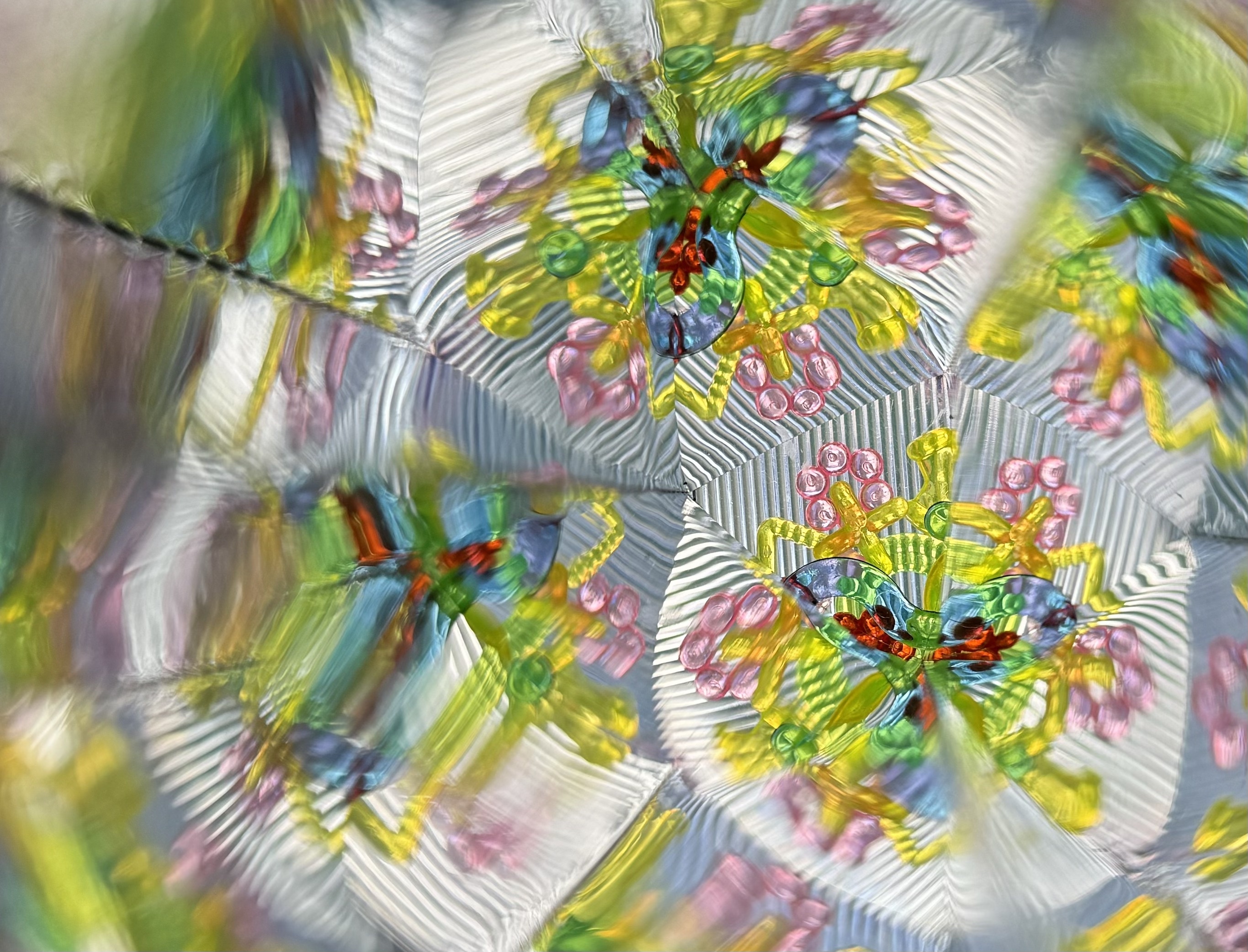
“O astonishing immateriality of distances!”
Sea and Fog, Etel Adnan
“You sometimes find yourself on a plane that isn’t the one you meant to go to.”
Changing Planes, Ursula K. Le Guin
I think of a day in the future when I will be able to board a plane. Any plane. I think about a day in the future when I will be able to change a plane. Any plane. But maybe it will be a train that will take me there, or a car, or a bike. Or I’ll just walk and see how far I can get. Eventually my feet will touch the sand and I will reach the ocean. And maybe I will enter it and see how much further I can push. Perhaps I will continue walking until the top of my head disappears in the waves, or maybe I will swim until my arms can’t hold me anymore. The cold water will carry me further and guide me to reach my destination. Oh sweet fantasy.
***
Ursula K. Le Guin begins her collection of stories Changing Planes by telling us about a character named Sita Dulip who discovered how to change planes. Found amidst the mundane setting of an airport, consumed by boredom while waiting for her next flight, Sita realizes that she can transport to a completely different plane of existence. The method becomes so popular and easily accessible that later on it is widely adopted by many others. All these different worlds suddenly become accessible. The borders vanish and distances disappear with sudden reachability being at once riveting and repulsing. Throughout the story, the narrator’s emotions alter between excitement and disillusionment from witnessing the imperfections and differences across other planes. While this collection is mostly described as a story of the challenges of comprehending different cultures, languages, and societies, I find another meaning for myself that more directly implicates the question of the sociopolitical dynamics between the individual and the collective, history and time. Le Guin’s depiction of different planes extends to the dynamics within the most intimate of environments, provoked by the smallest of social formations and found everywhere you look.
I don’t remember the first time I changed planes like Sita Dulip. But what I do recall is that it wasn’t at all related to any physical process (or even if it was, the physicality was secondary). Rather, it was a strong emotional sensation that carried on across time. I am convinced that, to this day, the after effect of the change is still present. The only difference is that it’s now layered with all these other kaleidoscopic changes, making it impossible to untangle what came before or after.1
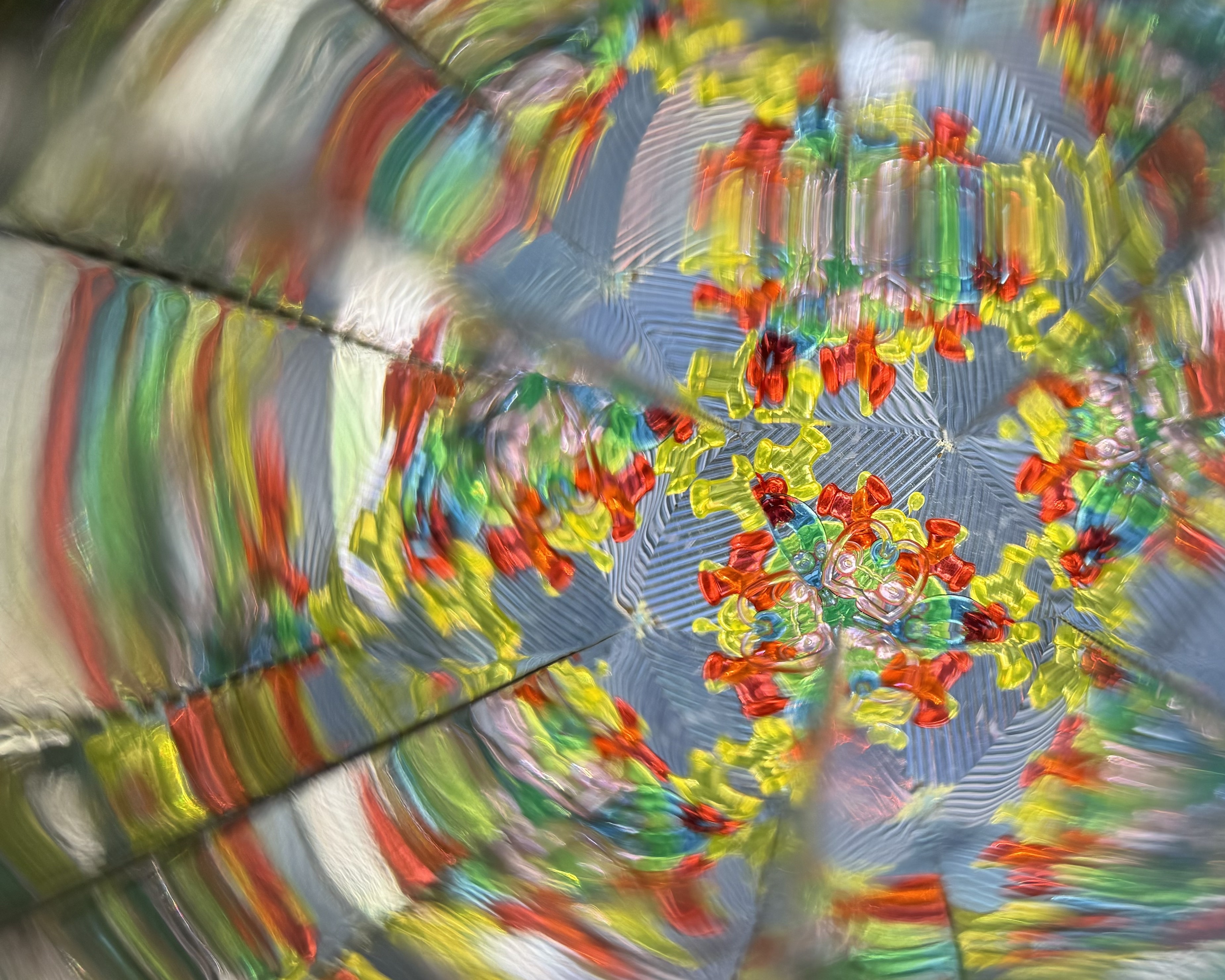
***
I stand at the threshold of the first plane; there’s a lot of silence here and so much void that it all feels sticky. It latches, it lingers, it doesn’t want to leave. But how can an absence be sticky and clingy like that when its sole purpose is to be reduced to nothingness, to not exist? Let me be clear: I am not here to pretend that I know about loss. Perhaps I know about some of it, but certainly not all. Yet I am also not here to deny that I don’t think about loss constantly. It’s a prolonged moment, a pause, before the inexorable split. One truly learns and understands loss and pain only through the act of living and so much of our learning about this is intertwined with the experience of those around us who undergo loss. What becomes of the silent witness to the suffering of a loved one who is torn between the desire for solitude and the scrutiny of society?
***
There’s no shortage of pain, as there’s no shortage of splinters. The sharp ache following the lingering presence of a splinter beneath one’s skin can be among the most exasperating pains. More often than not, one barely notices when a splinter penetrates their flesh. The prolonged presence of the foreign intruder often results in inflamed and damaged tissues; the body recognizes the object’s alien nature and attempts to expel it. The body’s resistance at its simplest. Pain, irritation, and soreness serve as indicators of the unwelcome intruder. As a child, picking out splinters with bare hands felt like an extreme accomplishment. While my mom would carefully sanitize and prepare a needle before removing the splinter from my skin, my sole satisfaction was diving straight in without any precaution. I was fascinated by the hollowness left after the foreign object was successfully eliminated, small yet large enough to feel. So as I enter this plane, I am marked by splinter cavities; their endless number renders my body foreign to itself. Like splinters, existing power structures leave cavities again and again until one reaches a level of detachment. Until one doesn’t belong to themselves.
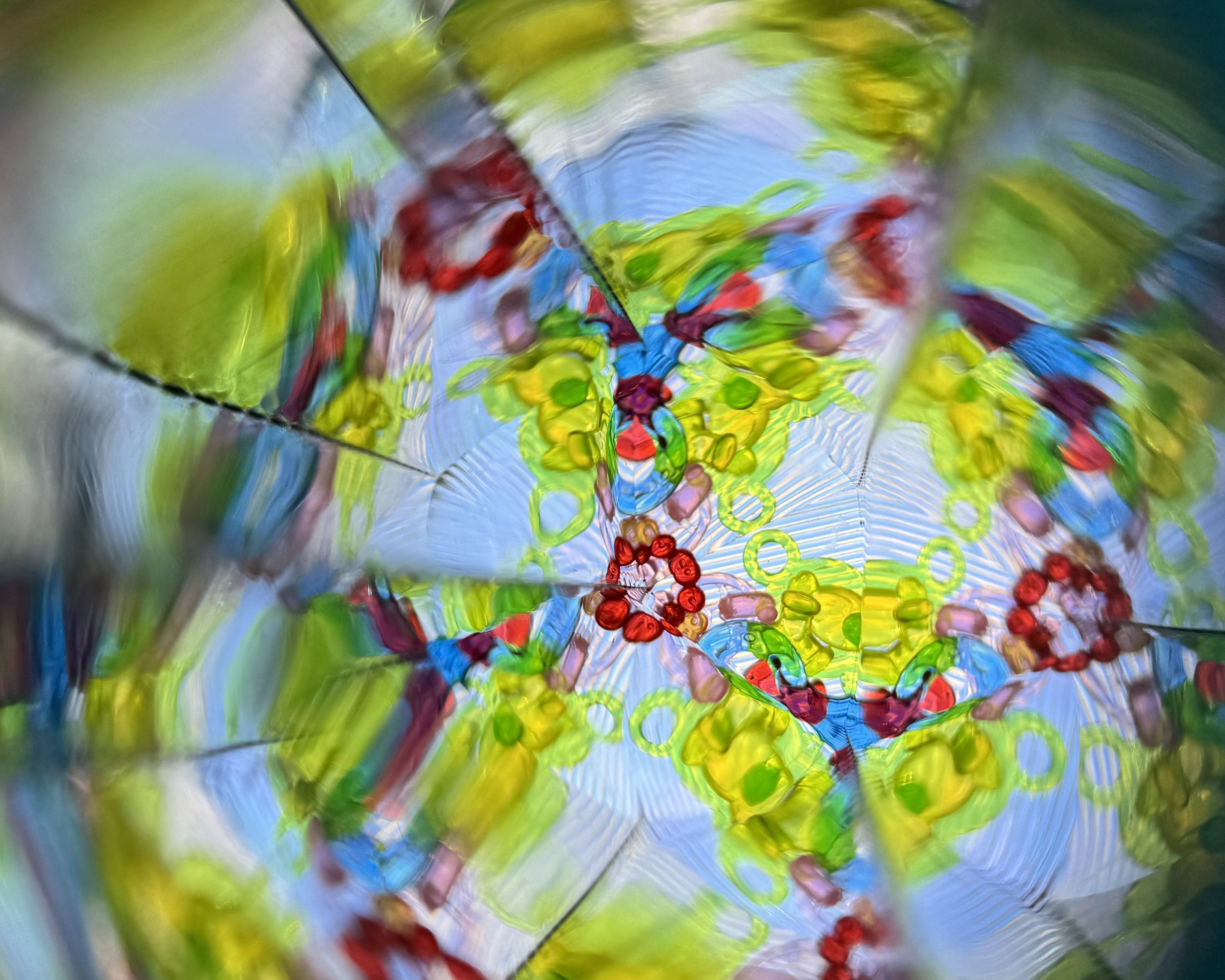
***
You want to imagine that you’re outside of it, but you must face that this is your personal delusion. You consume, you discard, you fixate. You resist repeating it, yet still fall into the same cycle. It’s daily, it’s weekly, yearly. It coincides with your birthday or the birthday of your loved one. Maybe a funeral if you’re less lucky. Something darker, something heavier. Devoid of joy or a decoy of joy. The luster of status and prestige, of upward mobility, exceptionality, or being better. There’s a plane that contains all of that, and it’s our reality. We don’t even have to go anywhere to imagine it because we live in it. We are the ones who maintain its alluringly putrid carcass. So then, what’s left is to wade through piles of bones, flesh, and tendons. This is the quality of the third plane: twisted abundance, trickery, and curses of time.
***
“Sometimes learning a fact is enough to make an entire series of corroborating details, previously unrecognized, fall into place,” thinks the narrator after receiving a call from Carlos Argentino in Jorge Luis Borges’s “The Aleph.”2 But how does fact differ from fiction, especially now in the wake of the 21st century? To enter the last fourth plane is to labor through the fear of the unknown and undetectable, to overcome the limits of our own imagination that measures this world by the standards of what is known and easily perceptible to humankind. To travel with light that surpasses everything around us; its perseverance evident even in the face of walls, deep voids, and secluded corners. Between the invisibility of the Earth's inner core and the infinity of outer space. So much of our relationship to the unseen and unreachable relies on acceptance and trust in our imagination. Otherwise everything would be darkness.
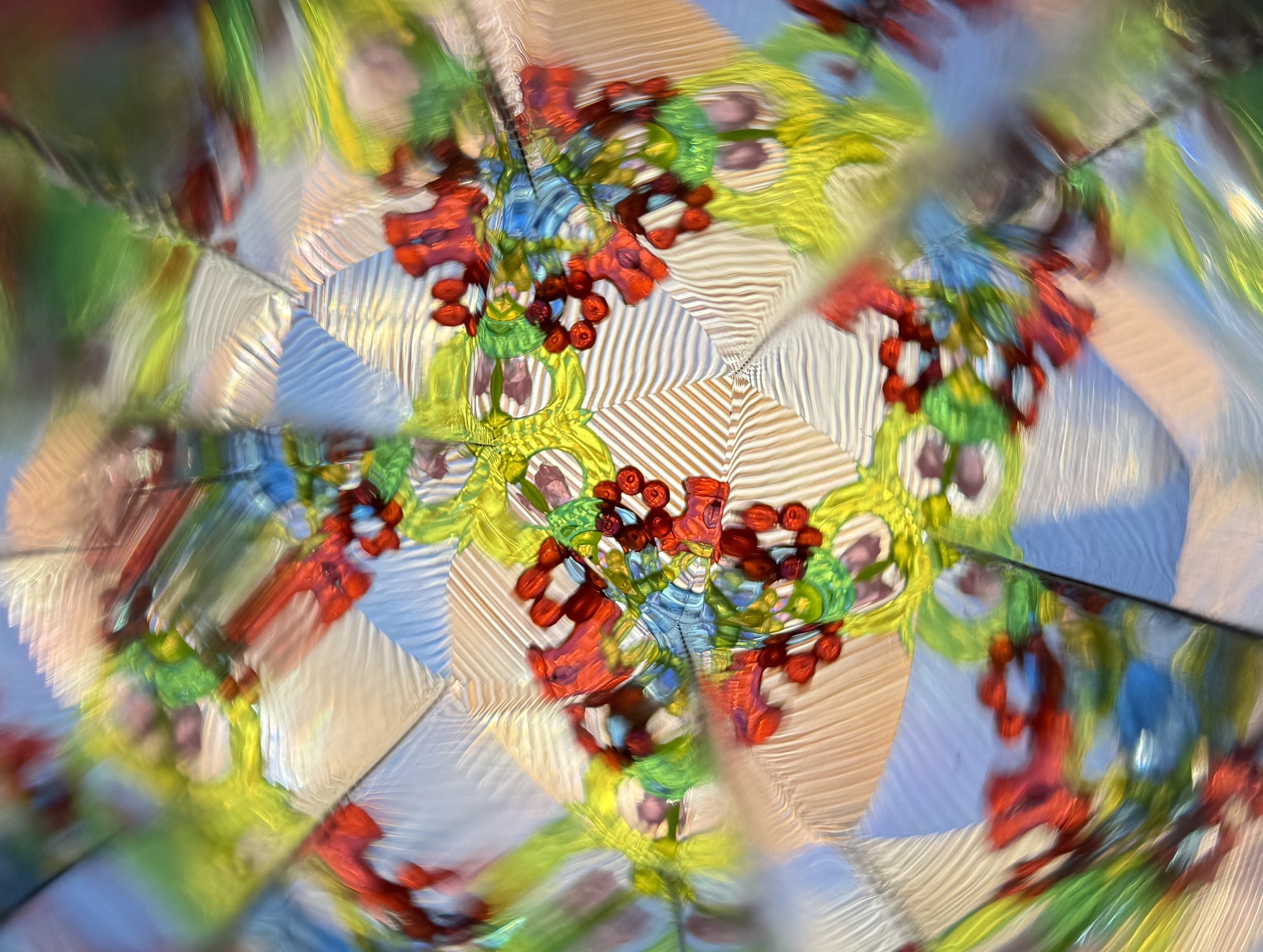
***
To change in this lifetime. Once, while writing a few words for this essay, I got a call from my mom. She was sharing about things back home and hinting at her frustrations with the family dynamic. “Everyone has their own picture of the world,” I heard her murmur. She has lived with the same three humans in one apartment for the past ten years, but having a familial relationship and sharing a consistent routine doesn’t guarantee the mutual understanding that we all crave throughout our lives. “It suddenly occurred to me that you don’t need order to live. There is no pattern to follow and the pattern itself doesn’t even exist: I am born,” proclaims Clari Lispector in Água Viva.3 Yet the feeling that we fall into the pattern forever haunts our steps. As we feel our planes of existence confine and close in upon us, the ability to change planes, relate to a story that is not immediately our own, and resist retreating into the isolation of set beliefs is what allows us to endure the forces of life alongside one another.
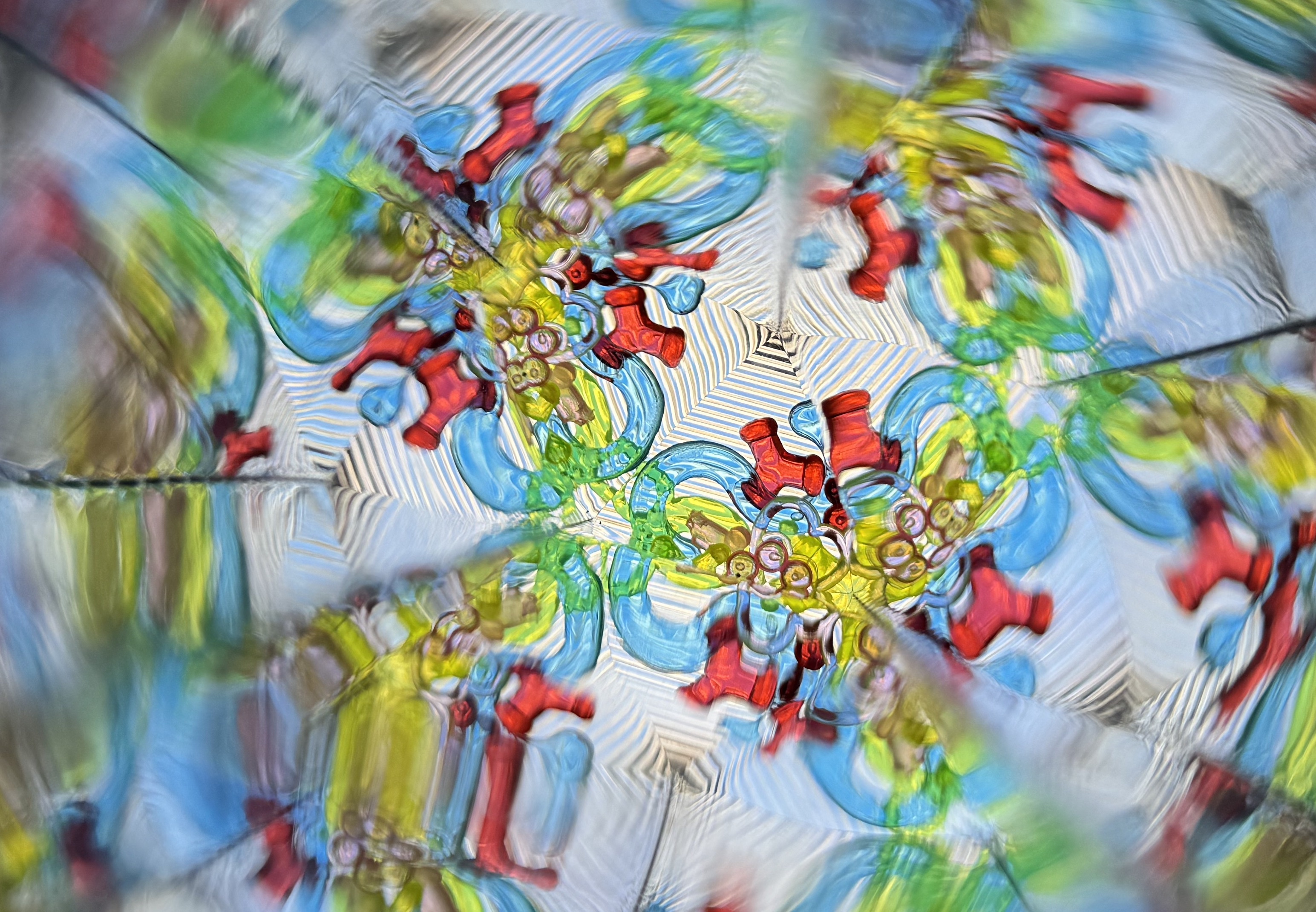
Note: This current Protodispatch text has been adapted from its earlier version written for Protozine: Parable of the Planes, published in conjunction with the exhibition Parable of the Planes, with artists Aiza Ahmed, Jaimie An, Ashley Bergner, Suiyuan Jin, Christine Jung, Da eun Lee, Elena Bulet i Llopis, Julia Helen Murray, Lorena Park, Suiyuan Jin, Shori Sims, a Protocinema Emerging Curator Series exhibition in partnership with Rhode Island School of Design Sculpture Department taking place at NADA East Broadway, New York from June 13 – 30, 2024.
References
- Here I am thinking about Clarice Lispector’s novel Agua Viva, where Lispector writes, “But I am kaleidoscopic: I am fascinated by my sparkling mutations that I here kaleidoscopically record.” Clarice Lispector, Água Viva (New York: New Directions, 2012), 27.
- Jorge Luis Borges, “The Aleph” in The Aleph and Other Stories (New York: Penguin Classics, 2004), 127.
- Clarice Lispector, Água Viva, 31.
***
ภาษาไทย
ตรงระหว่างเรื่อยไปกับไม่มีวัน

“โอ เจ้าระยะทางที่ไร้รูปร่าง ช่างน่าตื่นตะลึง!”
‘ทะเลแหละหมอก’ , เอเทล แอดนาน (Etel Adnan)
“คุณ บางครั้งก็พบว่าตัวเองอยู่ในเครื่องบินที่ไม่ใช่เครื่องที่คุณตั้งใจจะไป”
‘เปลี่ยนเครื่อง’, เออร์ซูล่า เค. เลอ กวิน (Ursula K. Le Guin)
ฉันนึกถึงวันสักวันในอนาคตในตอนที่ฉันจะสามารถขึ้นเครื่องบินได้ เครื่องบินลำไหนก็ได้ ฉันคิดถึงวันสักวันในอนาคตที่ฉันจะสามารถเปลี่ยนเครื่องบินได้ เครื่องบินลำไหนก็ได้ แต่บางทีมันอาจจะเป็นรถไฟมากกว่าที่จะพาฉันเดินทางไป หรือรถยนต์ หรือจักรยาน หรือฉันอาจจะแค่เดินไปและค่อยดูว่าฉันจะไปได้ไกลแค่ไหน แล้วในที่สุดเท้าของฉันจะสัมผัสกับทราย แล้วฉันจะได้สัมผัสมหาสมุทร และบางทีฉันจะกระโจนเข้าไปและดูว่าฉันจะดันตัวเองออกไปได้ไกลแค่ไหน บางทีฉันอาจจะเดินต่อไปจนหัวของฉันหายไปในคลื่น หรือบางทีฉันจะว่ายน้ำจนกว่าแขนของฉันจะไม่สามารถรับตัวฉันได้อีกต่อไป น้ำเย็นจะโอบอุ้มฉันออกไปไกลขึ้น ๆ และพาฉันไปถึงจุดหมายปลายทาง โอ จินตนาการอันหวานชื่น
เออร์ซูล่า เค. เลอ กวิน (Ursula K. Le Guin) เขียนเปิดเล่ม ‘Changing Planes’ ชุดเรื่องสั้นของเธอ ด้วยเรื่องของตัวละครที่ชื่อ สิตา ดูลิป (Sita Dulip) ผู้ค้นพบวิธีการเปลี่ยนเครื่องบิน ท่ามกลางสนามบินธรรมดา ๆ ในขณะที่ความเบื่อหน่ายในการรอขึ้นเที่ยวบินถัดไปกำลังกลืนกินตัวเธอ สิตาพบว่าเธอสามารถย้ายไปยังเครื่องบินอีกลำที่แตกต่างออกไปโดยสิ้นเชิงได้ วิธีของเธอกลายเป็นที่นิยมขึ้นมา แล้วมันก็ทำได้ง่ายมากจนผู้คนต่างนำไปใช้กันอย่างแพร่หลาย โลกทั้งหลายที่แตกต่างกันทั้งหมดนี้อยู่ ๆ ก็เลยกลายเป็นสิ่งที่เข้าถึงได้เสียอย่างนั้น พรมแดนและระยะห่างต่าง ๆ เลือนหายไปด้วยการเข้าถึงได้อย่างฉับพลัน ซึ่งมันทั้งน่าดึงดูดและน่าผลักไสไปพร้อมกัน ตลอดเรื่องเล่านั้น อารมณ์ของผู้เล่าเรื่องเปลี่ยนไปมาระหว่างความตื่นเต้นและความผิดหวัง จากการประสบพบความไม่สมบูรณ์แบบและความแตกต่างระหว่างเครื่องบินอื่น ๆ ถึงแม้ว่ารวมเรื่องสั้นชุดนี้จะถูกนิยามเป็นเรื่องราวของความท้าทายในการทำความเข้าใจวัฒนธรรม ภาษา และวัฒนธรรมที่แตกต่างกันออกไป ฉันกลับพบความหมายอีกอย่างหนึ่งสำหรับตัวฉันเอง ซึ่งพัวพันโดยตรงกับคำถามเกี่ยวกับพลวัตทางสังคมการเมืองระหว่างปัจเจกบุคคล กับส่วนรวม ประวัติศาสตร์ และเวลา คำบรรยายของเลอกวินเกี่ยวกับเครื่องบินลำต่าง ๆ งอกงามไปสู่เรื่องพลวัตภายในสภาพแวดล้อมที่ใกล้ชิดที่สุด ซึ่งถูกกระตุ้นโดยการก่อรูปทางสังคมที่เล็กที่สุด และอยู่ในทุกที่ที่สายตาไปถึง
ฉันจำไม่ได้แล้วว่าครั้งแรกที่ฉันเปลี่ยนเครื่องแบบสิตา ดูลิป เป็นอย่างไร แต่ฉันจำได้ว่ามันไม่ได้เกี่ยวข้องอะไรกับกระบวนการทางกายภาพเลย (หรือถึงจะเกี่ยว แต่ลักษณะทางกายภาพก็ยังเป็นเรื่องรอง) แต่มันเป็นเรื่องของประสบการณ์ทางอารมณ์ที่รุนแรงผ่านเวลามากกว่า ฉันเชื่อว่า มาจนถึงทุกวันนี้ ผลกระทบจากการเปลี่ยนแปลงนั้นยังคงอยู่ ความแตกต่างเพียงอย่างเดียวคือมันถูกซ้อนทับด้วยภาพการเปลี่ยนแปลงที่แตกกระจาย ทำให้มันเป็นไปไม่ได้เลยที่จะบอกว่าอะไรมาก่อนอะไรมาทีหลัง [1]

ฉันยืนอยู่ที่ทางเข้าขอเครื่องลำแรก; มันมีแต่ความเงียบและความว่างเปล่าเต็มไปหมดจนทำให้รู้สึกเหนียวเหนอะหนะไปหมด มันคงอยู่ อ้อยอิ่ง มันไม่อยากจากลา แต่ความไม่มีอยู่มันจะเหนียวและติดหนึบอย่างนั้นได้อย่างไร ในเมื่อเป้าหมายเดียวของมันคือการลดรูปหลงเหลือเพียงความว่างเปล่า ที่จะไม่มีอยู่ ฉันจะพูดชัด ๆ ฉันไม่ได้จะมาแสร้งทำรู้ดีว่าการสูญเสียคืออะไร บางทีฉันอาจจะรู้เกี่ยวกับมันบ้าง แต่ไม่ใช่ทั้งหมดแน่นอน แต่ฉันก็ไม่ได้จะมาปฏิเสธว่าฉันไม่ได้คิดถึงการสูญเสียอยู่ตลอดเวลาเหมือนกัน มันเป็นช่วงเวลาที่ยืดยื้อ การหยุดชะงัก ก่อนจะแยกออกจากกันอย่างหลีกเลี่ยงไม่ได้ เราจะเรียนรู้และเข้าใจเกี่ยวกับการสูญเสียและความเจ็บปวดอย่างถ่องแท้ก็ต่อเมื่อเราก้าวผ่านการใช้ชีวิตมาแล้ว และสิ่งที่เราเรียนรู้เกี่ยวกับเรื่องนี้ส่วนใหญ่ก็เกี่ยวพันอยู่กับประสบการณ์รอบตัวของการสูญเสียบางคนไป แล้วพยานที่เงียบงันแห่งความเจ็บปวดของการที่คนรักถูกพรากออก ระหว่างความปรารถนาที่จะอยู่ลำพังกับการเฝ้าดูของสังคม มันคืออะไรกัน?
ปัญหาการขาดแคลนของความเจ็บปวดไม่มีอยู่จริง เพราะว่ามันก็ไม่มีปัญหาการขาดแคลนของในเสี้ยนหนามเช่นเดียวกัน การเจ็บแปลบที่ตามหลังมาจากเสี้ยนแทงค้างอยู่ใต้ผิวหนังของเราอาจเป็นหนึ่งในความเจ็บปวดที่น่ารำคาญที่สุด บ่อยครั้งเราแทบจะไม่รู้ตัวเลยด้วยซ้ำในตอนที่เสี้ยนแทงทะลุเนื้อ แต่การคงอยู่ที่ยาวนานของเจ้าวัตถุแปลกปลอมนี้ส่งผลให้เกิดการอักเสบและเนื้อเยื่อเสียหายได้; ร่างกายรับรู้ถึงลักษณะที่แปลกปลอมของวัตถุนั้นและพยายามขับไล่มันออกไป การต่อต้านของร่างกายในรูปแบบที่เรียบง่ายที่สุด ความเจ็บปวด การระคายเคือง และอาการคัน ทำหน้าที่เป็นตัวส่งสัญญาณว่ากำลังมีผู้บุรุกไม่น่าพึงประสงค์เข้ามาอยู่ เมื่อตอนเป็นเด็ก การถอนเสี้ยนด้วยมือเปล่าได้ให้ความรู้สึกเหมือนเราเอาชนะอะไรที่ยิ่งใหญ่สักอย่างได้ ในขณะที่แม่ของฉันค่อย ๆ ทำเช็ดแผลและเตรียมเข็มอย่างระมัดระวังเพื่อจะเอาเสี้ยนออกจากผิวของฉัน ความรู้สึกพึงใจเดียวของฉันคือการดำดิ่งลงไปโดยไม่มีการป้องกันใด ๆ ฉันหลงใหลในความกลวงเปล่าที่หลงเหลืออยู่หลังจากวัตถุแปลกปลอมนั้นถูกกำจัดออกไปสำเร็จ ความกลวงเปล่าเล็ก ๆ แต่ก็ใหญ่พอที่จะสัมผัสได้ แล้วพอฉันเข้าไปยังยานนี้ ฉันจึงตระหนักได้ถึงโพรงเสี้ยน; จำนวนที่ไม่มีที่สิ้นสุดของมันทำให้ร่างกายของฉันกลายเป็นสิ่งแปลกปลอมต่อตัวมันเอง และเช่นเดียวกันกับเสี้ยน โครงสร้างอำนาจที่มีอยู่เจาะรูไว้รูแล้วรูเล่า จนกระทั่งถึงจุดที่มันแยกวัตถุออกจากกัน จนกว่าเราจะไม่ได้เป็นส่วนหนึ่งของตัวเอง

คุณอยากจะจินตนาการว่าตัวคุณเองอยู่ภายนอกมัน แต่คุณก็ต้องเผชิญหน้ากับความจริงที่ว่านี่เป็นภาพลวงตาส่วนตัวของคุณเองด้วย คุณบริโภค คุณละทิ้ง คุณหมกมุ่น คุณต่อต้านการทำมันซ้ำ ๆ แต่คุณก็ยังตกเข้าไปอยู่ในวงจรเดิมซ้ำ ๆ มันเกิดขึ้นทุกวัน ทุกสัปดาห์ ทุกปี มันอยู่ในวันเกิดของคุณ หรือวันเกิดของคนที่คุณรัก หรืออาจจะเป็นงานศพก็ได้ถ้าคุณโชคไม่ดี บางอย่างที่มืดมนกว่า หนักหน่วงกว่า ปราศจากความสุข หรือล่อลวงความสุขมา ความเจิดจ้าของสถานะและเกียรติยศ ของการเลื่อนขั้นฐานะทางสังคม ความพิเศษ หรือออะไรที่ดีกว่า มันมีเครื่องที่บรรจุอะไรทั้งหมดเหล่านั้น และนั่นคือความเป็นจริงของเรา เราไม่จำเป็นต้องไปไหนเลยเพื่อที่จะมองเห็นมัน เพราะว่าเราใช้ชีวิตอยู่ข้างในตัวมัน พวกเราคือผู้รักษาซากศพอันเน่าเปื่อยแต่น่าดึงดูดของมันเอาไว้ ดังนั้น สิ่งที่พอเหลือคือการตะลุยผ่านกองกระดุก เนื้อ และเอ็น นี่คือคุณลักษณะของเครื่องที่สาม: อุดมสมบูรณ์แบบบิดเบี้ยว ลวงตา และโดนสาปด้วยเวลา
“บางครั้ง แค่การเรียนรู้ข้อเท็จจริง ก็เพียงพอที่จะทำให้รายละเอียดต่าง ๆ นา ๆ ซึ่งก่อนหน้านี้ไม่เคยถูกสังเกตเห็น เข้าที่เข้าทางกัน” ตัวละครผู้เล่าเรื่องคิด หลังจากได้รับโทรศัพท์จากคาร์ลอส อาร์เจนติโน ในเรื่องสั้น "The Aleph" ของฮอร์เฮ หลุยส์ บอร์เฆส (Jorge Luis Borges) [2] แต่สภาพความเป็นจริงเป็นเหมือนกับเรื่องแต่งไหม โดยเฉพาะในรุ่งอรุณแห่งศตวรรษที่ 21 นี้? และการเข้าสู่เครื่องลำที่สี่ซึ่งเป็นลำระนาบสุดท้าย ก็คือการดิ้นรนผ่านความกลัวต่อสิ่งที่เราไม่รู้จักและไม่สามารถตรวจพบได้ เพื่อเอาชนะขีดจำกัดจินตนาการของเราเอง ในการวัดโลกนี้ด้วยมาตรฐานของสิ่งที่รู้จักและรับรู้ได้ง่ายสำหรับมนุษย์ เพื่อเดินทางไปกับแสงที่เหนือกว่าทุกสิ่งรอบตัวเรา ความอึดของมันปรากฏชัดแม้ในยามเผชิญหน้ากับผนังกำแพง ความว่างเปล่าลึก และมุมที่ฉีกตัวออกไป ระหว่างสภาวะไม่ปรากฏของแก่นโลกและความไม่มีที่สิ้นสุดของอวกาศภายนอก ความสัมพันธ์ของเรากับสิ่งที่มองไม่เห็นและเอื้อมไม่ถึงส่วนใหญ่ของเรา ขึ้นอยู่กับการยอมรับและความเชื่อมั่นในจินตนาการของเรา มิฉะนั้นทุกอย่างก็จะเป็นความมืด

การจะเปลี่ยนแปลงในชีวิตนี้ ครั้งหนึ่ง ขณะที่เขียนอะไรไปได้นิดหนึ่งสำหรับบทความนี้ ฉันได้รับโทรศัพท์จากแม่ เธอเล่าเรื่องต่าง ๆ จากทางบ้านโดยสื่อเป็นนัย ๆ ถึงความหงุดหงิดของเธอต่อความสัมพันธ์ในครอบครัว “ทุกคนมีภาพของโลกในแบบของตัวเอง” ฉันได้ยินเธอพึมพำ เธออาศัยอยู่กับคนสามคนเดิมในอพาร์ตเมนต์เดิม ๆ มาเป็นเวลานับสิบปีแล้ว แต่การมีความสัมพันธ์แบบครอบครัวและมีกิจวัตรประจำวันที่สม่ำเสมอ ไม่ได้รับประกันความเข้าอกเข้าใจกันที่เราทุกคนปรารถนาอยู่ตลอดชีวิต “ฉันนึกขึ้นมาได้ทันทีว่าคุณไม่จำเป็นต้องมีระเบียบเพื่อมีชีวิตอยู่ มันไม่มีรูปแบบอะไรให้ทำตาม และตัวรูปแบบเองก็ไม่มีอยู่จริง: ฉันเพียงเกิดมา” คลาริซ ลิสเปกเตอร์ (Clari Lispector) ประกาศใน Água Viva [3] แต่ความรู้สึกว่าเราตกอยู่ในรูปแบบตลอดไปยังคงหลอกหลอนทุกย่างก้าวของเรา เมื่อเรารู้สึกว่าเครื่องแห่งการดำรงอยู่ของเราจำกัดและปิดล้อมเราไว้ ความสามารถในการเปลี่ยนเครื่อง การเชื่อมโยงกับเรื่องราวที่ไม่ใช่ของเราโดยตรง และการต่อต้านกระบวนการถอยกลับไปสู่ความโดดเดี่ยวของชุดความเชื่อที่ตายตัว คือสิ่งที่ช่วยให้เราทนทานต่อแรงกดดันของชีวิตไปพร้อมกัน

หมายเหตุ: บทความ Protodispatch ฉบับนี้ปรับปรุงมาจากฉบับก่อนหน้าที่เขียนขึ้นสำหรับ Protozine: Parable of the Planes ซึ่งตีพิมพ์ร่วมกับนิทรรศการ Parable of the Planes ของศิลปิน Aiza Ahmed, Jaimie An, Ashley Bergner, Suiyuan Jin, Christine Jung, Da eun Lee, Elena Bulet i Llopis, Julia Helen Murray, Lorena Park, Suiyuan Jin, Shori Sims ซึ่งเป็นนิทรรศการในซีรีส์ Protocinema Emerging Curator ร่วมกับภาควิชาประติมากรรม Rhode Island School of Design ขึ้นที่ NADA East Broadway นิวยอร์ก ระหว่างวันที่ 13-30 มิถุนายน 2567
อ้างอิง
[1] ตรงนี้ฉันนึกถึงนิยายของคลาริส ลิสเปกเตอร์ (Clarice Lispector) ‘Agua Viva’ ที่เธอเขียนว่า “แต่ฉันเป็นแบบคาไลโดสโคป (กล้องสลับลาย): ฉันหลงใหลในประกายที่เปล่งปลั่งซึ่งฉันบันทึกไว้นี้แบบส่องสะท้อนแตกกระจาย” Clarice Lispector, Água Viva (New York: New Directions, 2012), 27.
[2] Jorge Luis Borges, “The Aleph” in The Aleph and Other Stories (New York: Penguin Classics, 2004), 127.
[3] Clarice Lispector, Água Viva, 31.
